Impact of Climate Conditions on Pollutant Concentrations in the Effluent from a One-Stage Constructed Wetland: A Case Study
Abstract
:1. Introduction
2. Materials and Methods
2.1. Description of the One-Stage Constructed Wetland
2.2. Description of the Database and Basic Analyses
- −
- The content of TSS was determined by the direct gravimetric method while using filters;
- −
- BOD5 was determined by the dilution method (O2 concentration was measured using an Oxi 538 oxygen meter from WTW):
- −
- CODCr was determined by the dichromate method (COD was measured with an MPM 2010 photometer from WTW after a prior oxidation of a sample in a thermoreactor at 148 °C);
- −
- The concentration of total nitrogen was determined with a PCspectro spectrophotometer from AQUALYTIC after the oxidation of a sample in a thermoreactor at 100 °C;
- −
- The concentration of total phosphorus was determined with the MPM 2010 photometer from WTW after the oxidation of a sample in a thermoreactor at 120 °C.
2.3. Precipitation and Temperature in the Study Period
3. Results and Discussion
3.1. Wastewater Treatment Efficiencies during the Growing Season
3.2. Wastewater Treatment Efficiencies in the Non-Growing Season
3.3. Impact of Precipitation and Temperature on the Concentration of Pollutants
- -
- With an increase in precipitation, the contents of TSS and BOD5 decreased. A 10 mm rise in precipitation caused a drop in TSS by approx. 1.7 mg/L and a drop in BOD5 by approx. 1.1 mg/L;
- -
- With an increase in temperature, the contents of TSS and BOD5 decreased. A 1 °C rise in temperature caused a drop in TSS by approx. 3.8 mg/L and a drop in BOD5 by approx. 2.4 mg/L.
- -
- With an increase in precipitation, the contents of TSS, TN, and TP decreased. A 10 mm rise in precipitation caused a decrease in TSS content by approx. 5.3 mg/L, a decrease in TN content by approx. 2.5 mg/L, and a decrease in TP content by approx. 0.7 mg/L;
- -
- With an increase in temperature, the contents of TSS, BOD5, COD, and TP decreased. A 1 °C rise in temperature caused decreases in TSS by approx. 2.5 mg/L, in BOD5 by approx. 3.8 mg/L, in COD by approx. 4.5 mg/L, and in TP by approx. 0.6 mg/L.
4. Conclusions
Author Contributions
Funding
Institutional Review Board Statement
Informed Consent Statement
Data Availability Statement
Conflicts of Interest
References
- Lenaerts, K.; Tagliapietra, S.; Wolff, G.B. How Can the European Union Adapt to Climate Change? Inter. Econ. 2022, 57, 314–321. [Google Scholar] [CrossRef]
- EEA. Global and European Temperatures. Available online: https://www.eea.europa.eu/ims/global-and-european-temperatures (accessed on 18 November 2021).
- EEA. Wet and Dry—Heavy Precipitation and River Floods. Available online: https://climate-adapt.eea.europa.eu/metadata/indicators/precipitation-sum-2011-2099# (accessed on 19 November 2021).
- Dimkić, D. Temperature impact on drinking water consumption. Environ. Sci. Proc. 2020, 2, 2673–4931. [Google Scholar]
- Brack, W.; Hollender, J.; de Alda, M.L.; Müller, C.; Schulze, T.; Schymanski, M.; Slobodnik, J.; Kraus, M. High-resolution mass spectrometry to complement monitoring and track emerging chemicals and pollution trends in European water resources. Environ. Sci. Eur. 2019, 31, 31–62. [Google Scholar]
- Operacz, A.; Kurek, K.; Bugajski, P.; Pardal, A.; Simões, I.; Imaginário, M.J.; Castanheira, I.; Raposo, M.; Almeida, A. The physio-chemical conditions of surface and groundwater resources in water scarce areas—How droughts affect ions migration. Desalin. Water Treat. 2020, 207, 122–136. [Google Scholar] [CrossRef]
- Bodik, I.; Kubaska, M. Energy and sustainability of operation of a wastewater treatment plant. Environ. Prot. Eng. 2013, 39, 15–24. [Google Scholar] [CrossRef]
- Baumann, P.; Krauth, K.H.; Maier, W.; Roth, M. Operational Problems in Wastewater Treatment Plants, 1st ed.; DWA Landesverband Baden: Württemberg, Germany, 2012. [Google Scholar]
- Jawecki, B.; Sobota, M.; Pawęska, K. The construction of domestic wastewater treatment plant in according to selected provisions of local spatial development plans and the judgements of administrative courts. Acta Sci. Pol. Adm. Locorum. 2017, 1, 7–18. (In Polish) [Google Scholar]
- Pryszcz, M.; Mrowiec, B.-M. Operation of the household sewage treatment plants in Poland. Ecol. Eng. 2015, 41, 133–141. [Google Scholar]
- Migdał, K.; Operacz, A.; Vaskina, I.; Śliz, P.; Tavares, J.; Almeida, A.; Migdał, M. Assessment of the reliability of the operation of a sewage treatment plant using Monte Carlo simulation. J. Water Land Dev. 2022, Special Issue, 80–90. [Google Scholar]
- Bugajski, P.; Operacz, A.; Młyński, D.; Wałęga, A.; Kurek, K. Optimizing Treatment of Cesspool Wastewater at an Activated Sludge Plant. Sustainability 2020, 12, 10196. [Google Scholar] [CrossRef]
- Marzec, M. Efficiency of removing organic pollutants from wastewater in a household wastewater treatment plant with a hybrid reactor. J. Ecol. Eng. 2016, 17, 240–246. [Google Scholar] [CrossRef]
- Marzec, M. Reliability of removal of selected pollutants in different technological solutions of household wastewater treatment plants. J. Water Land Dev. 2017, 35, 141–148. [Google Scholar]
- Roman, M.-D.; Sava, C.; Iluțiu-Varvara, D.A.; Mare, R.; Pruteanu, L.-L.; Piča, E.M.; Jäntschi, L. Biological Activated Sludge from Wastewater Treatment Plant before and during the COVID-19 Pandemic. Int. J. Environ. Res. Public Health 2022, 19, 11323. [Google Scholar] [PubMed]
- Gajewska, M.; Obarska-Pempkowiak, H. 20 Years of experience of hybrid constructed wetlands exploitation in Poland. Annual. Rev. Env. Ress. 2009, 11, 875–888. (In Polish) [Google Scholar]
- Vymazal, J. Constructed wetlands for wastewater treatment: Five decades of experience. Environ. Sci. Technol. 2011, 45, 61–69. [Google Scholar]
- Gajewska, M.; Jóźwiakowski, K.; Ghrabi, A.; Masi, F. Impact of influent wastewater quality on nitrogen removal rates in multistage treatment wetlands. Environ. Sci. Pollut. Res. 2015, 22, 12840–21284. [Google Scholar]
- Jóźwiakowski, K.; Marzec, M.; Kowalczyk-Juśko, A.; Gizińska-Górna, M.; Pytka-Woszczyło, A.; Malik, A.; Listosz, A.; Gajewska, M. 25 years of research and experiences about the application of constructed wetlands in southeastern Poland. Ecol. Eng. 2019, 127, 440–453. [Google Scholar]
- Ji, M.; Hu, Z.; Hou, C.; Liu, H.; Ngo, H.H.; Guo, W.; Lu, S.; Zhang, J. New insights for enhancing the performance of constructedwetlands at low temperatures. Bioresour. Technol. 2020, 301, 122722. [Google Scholar]
- Xu, D.; Xiao, E.; Xu, P.; Zhou, Y.; Zhou, Q.; Xu, D.; Wu, Z. How Temperature Affects Wastewater Nitrate Removal in a Bioelectrochemically Assisted Constructed Wetland System. Pol. J. Environ. Stud. 2018, 27, 953–958. [Google Scholar]
- Kadlec, R.H.; Reddy, K.R. Temperature effects in treatment wetlands. Water Environ. Res. 2001, 73, 543–557. [Google Scholar]
- Myszograj, S.; Bydałek, F.A. Temperature impact of nitrogen transformation in technological system: Vertical flow constructed wetland and polishing pond. Civ. Environ. Eng. Rep. 2016, 23, 125–136. [Google Scholar]
- Mietto, A.; Politeo, M.; Breschigliaro, S.; Borin, M. Temperature influence on nitrogen removal in a hybrid constructed wetland system in Northern Italy. Ecol. Eng. 2015, 75, 291–302. [Google Scholar]
- Jóźwiakowska, K.; Bugajski, P. Influence of the Bed Temperature on the Operational Reliability of a Hybrid Constructed Wetland Wastewater Treatment Plant in South-Western Poland—A Case Study. Sustainability 2023, 15, 11790. [Google Scholar]
- Gregersen, P.; Brix, H. Zero-discharge of nutrients and water in a willow dominated constructed wetland. Water Sci. Technol. 2001, 44, 407–412. [Google Scholar] [PubMed]
- Mucha, Z.; Wójcik, W.; Jóźwiakowski, K.; Gajewska, M. Long-term operation of Kickuth-type constructed wetland applied to municipal wastewater treatment in temperate climate. Environ. Technol. 2018, 39, 1133–1143. [Google Scholar] [PubMed]
- Jóźwiakowski, K.; Bugajski, P.; Kurek, K.; Cáceres, R.; Siwiec, T.; Jucherski, A.; Czekała, W.; Kozłowski, K. Technological reliability of pollutant removal in different seasons in one-stage constructed wetland system with horizontal flow operating in the moderate climate. Sep. Purif. Technol. 2020, 238, 1383–5866. [Google Scholar]
- Nixon, S.; Trent, Z.; Marcuello, C.; Lallana, C. Europe’s Water: An Indicator-Based Assessment; Topic Report1/2003; European Environment Agency: Copenhagen, Denmark, 2003; ISBN 92-9167-581-4. [Google Scholar]
- Kowalczyk-Juśko, A.; Listosz, A.; Joźwiakowski, K.; Urban, D.; Ramalho Durao, A.C. The assessment of the possibility of using energy from common reed biomass from the constructed wetland wastewater treatment plant. In 16th IWA International Conference on Wetland Systems for Water Pollution Control; Universitat Politecnica de Valencia: Valencia, Spain, 2018; pp. 583–586. [Google Scholar]
- Jóźwiakowski, K. Studies on the efficiency of sewage treatment in chosen constructed wetland systems. Infrastruct. Ecol. Rural. Areas 2012, 1, 232. (In Polish) [Google Scholar]
- Regulation of Polish Minister of the Environment of 24 July 2006 on the Conditions of Discharging Sewage into Waters or into the Ground and on Substances Particularly Harmful to the Aquatic Environment (Rozporządzenie Ministra Środowiska z dnia 24 lipca 2006 r. w Sprawie Warunków, Jakie Należy Spełnić Przy Wprowadzaniu Ścieków do Wód Lub do ziemi oraz w Sprawie Substancji Szczególnie Szkodliwych Dla Środowiska Wodnego. Dz. U nr 137, poz. 984). (In Polish). Available online: https://isap.sejm.gov.pl/isap.nsf/DocDetails.xsp?id=wdu20061370984 (accessed on 18 November 2021).
- Stanisz, A. An Accessible Course in Statistics; Wydawnictwo StatSoft Polska Sp. z o.o.: Kraków, Poland,, 1998; Volume I. [Google Scholar]
- Kuczewski, K.; Paluch, J. Treatment of domestic wastewater in rural areas in plant-soil treatment plants. Zesz. Nauk. AR We. Wrocławiu. 1997, 309, 314. (In Polish) [Google Scholar]
- Dong, Y.; Wiliński, P.R.; Dzakpasu, M.; Scholz, M. Impact of Hydraulic Loading Rate and Season on Water Contaminant Reductions Within Integrated Constructed Wetlands. Wetlands 2011, 31, 499–509. [Google Scholar]
- Qiusheng, G.; Liang, D.; Jianing, L.; Hengliang, Z.; Yang, Z. Evaluation and optimization of reverse osmosis pretreatment technology using the modified intermediate blocking model. J. Clean Prod. 2023, 417, 138029. [Google Scholar]
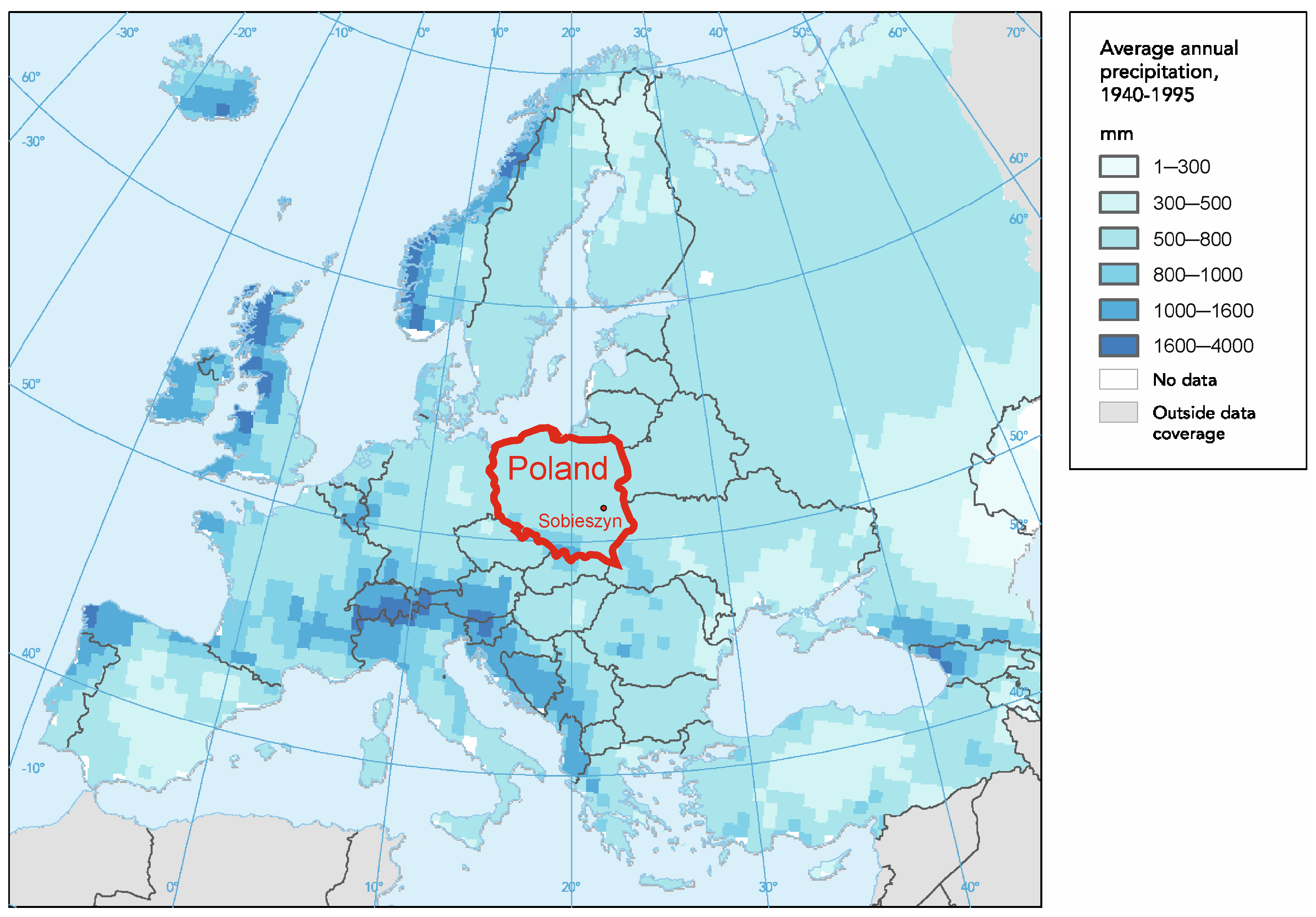
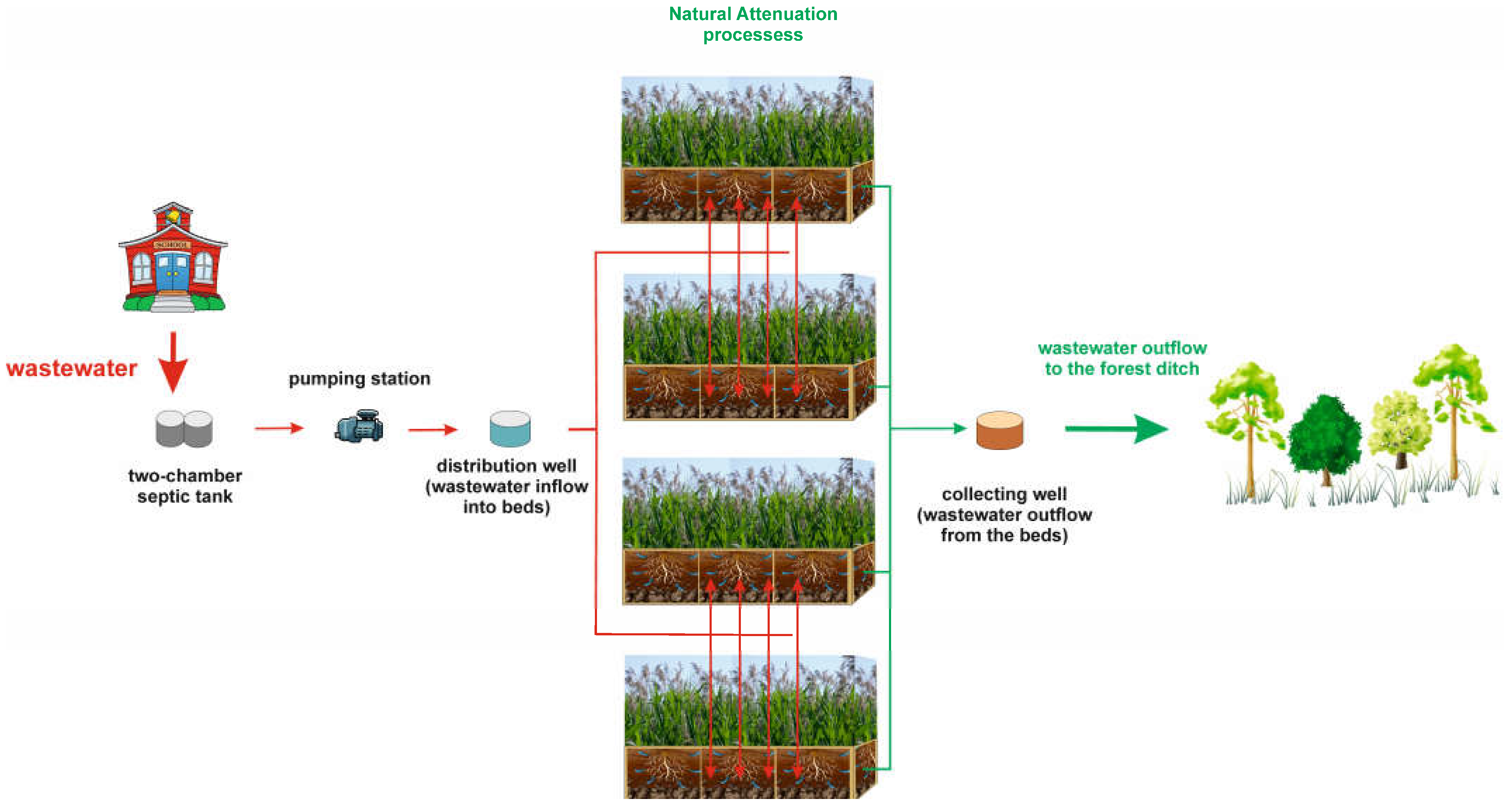
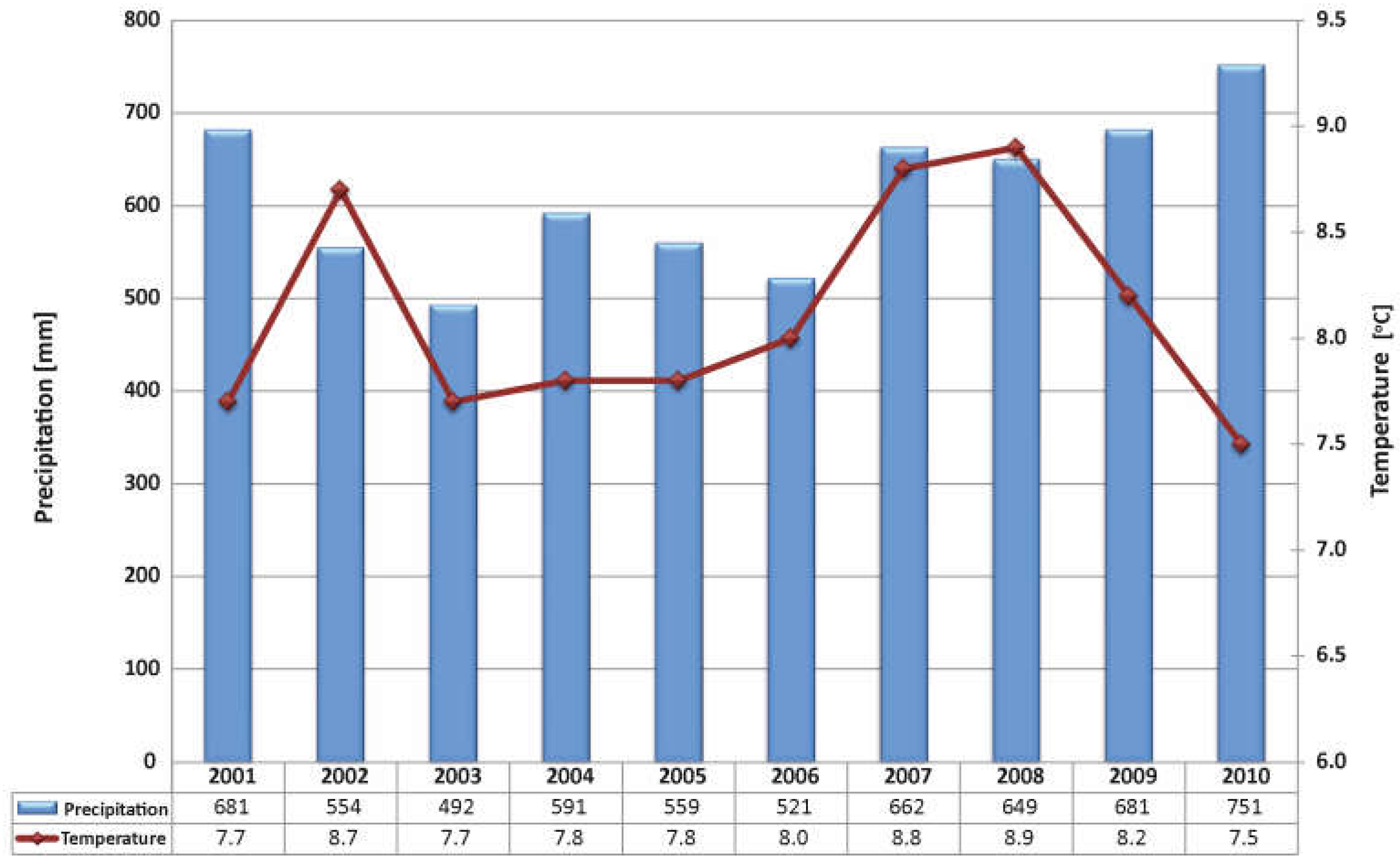
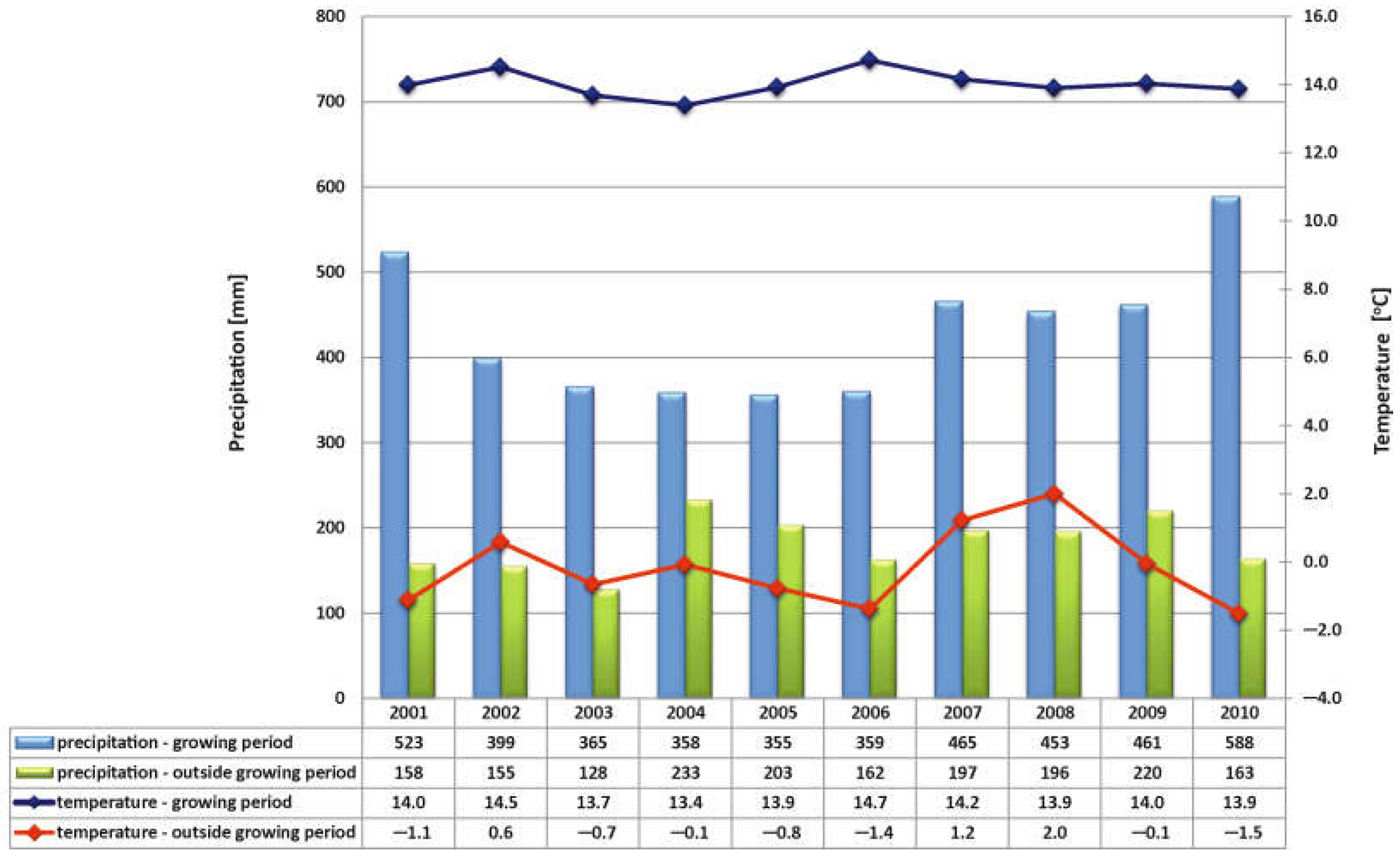
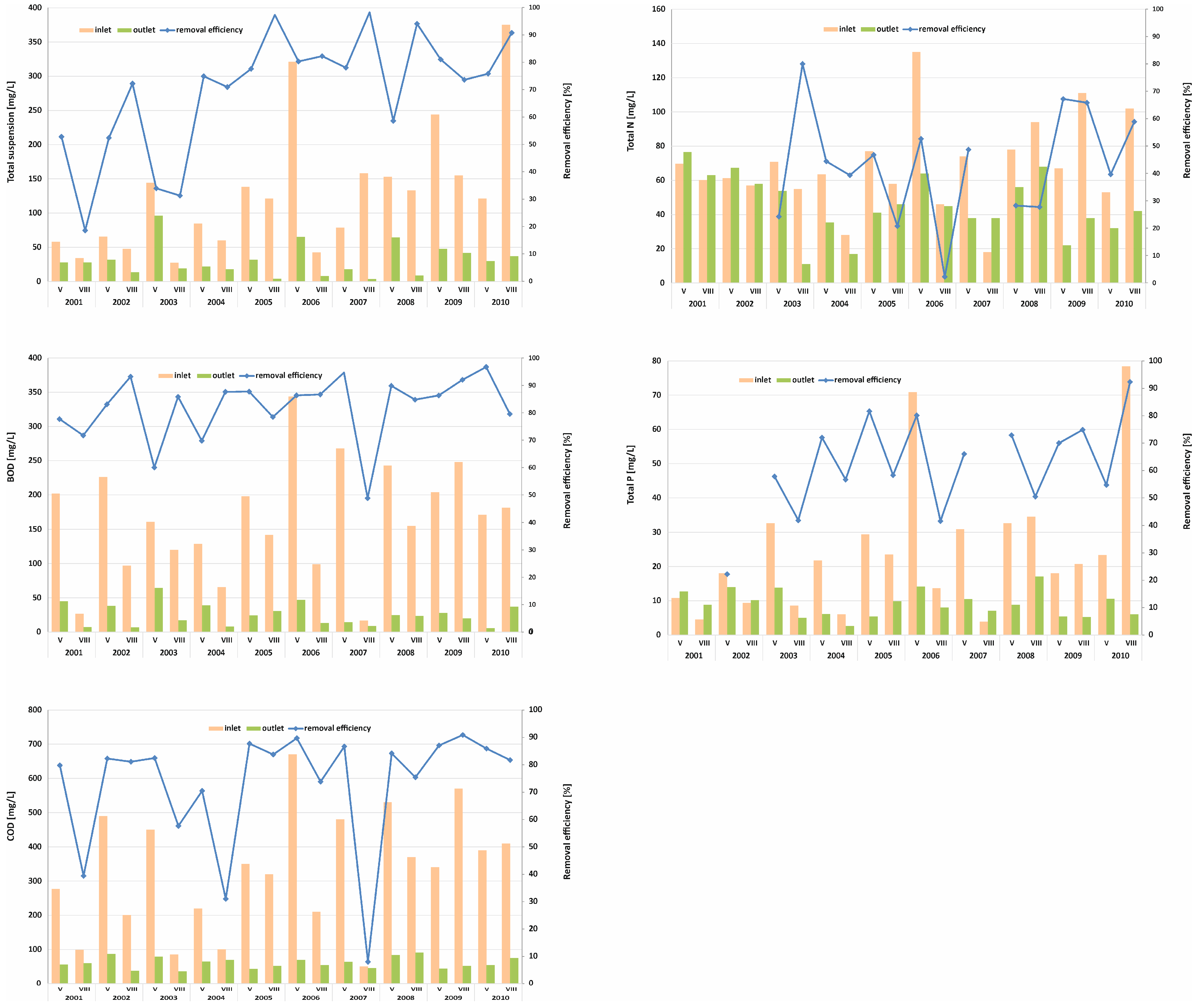
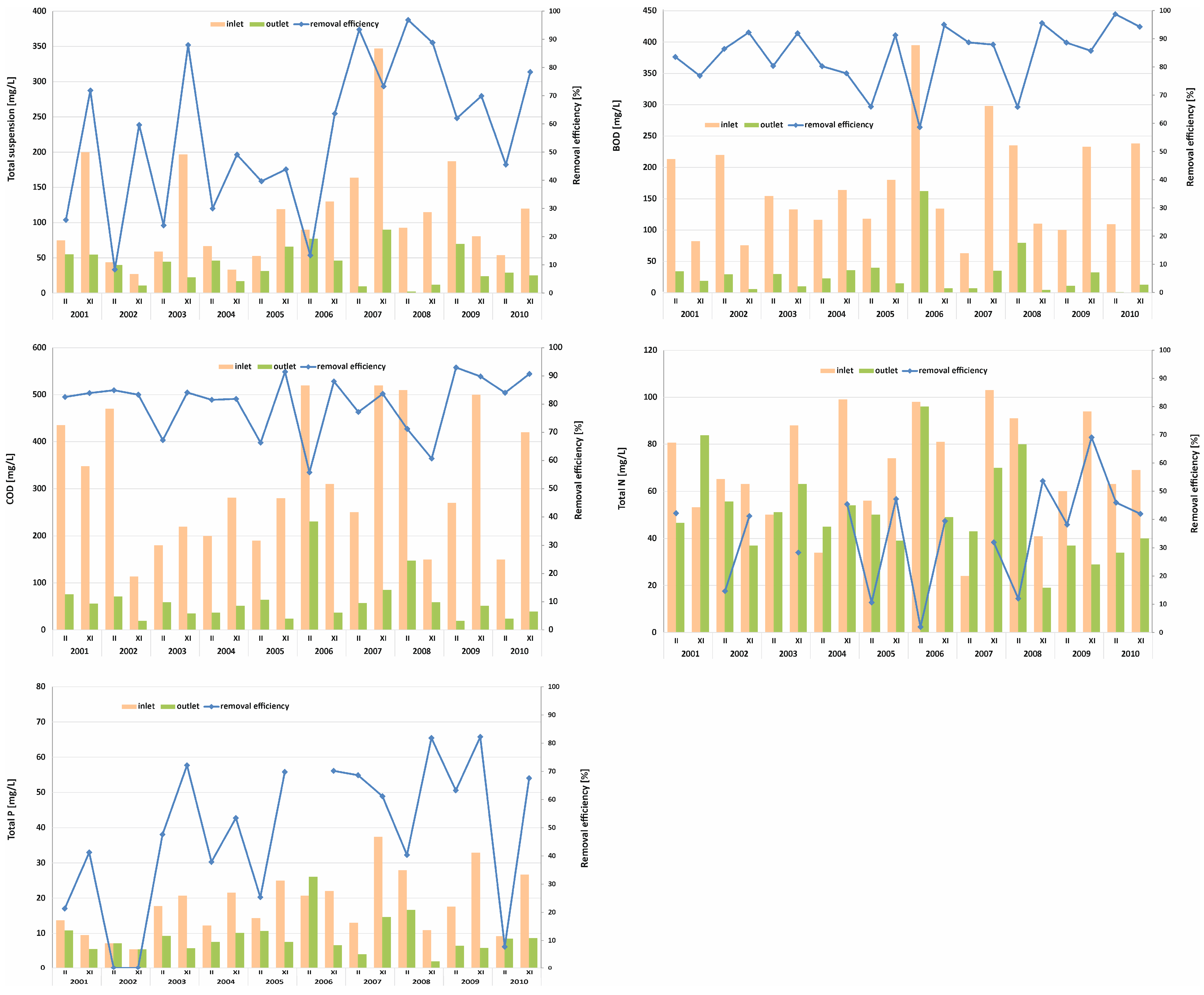


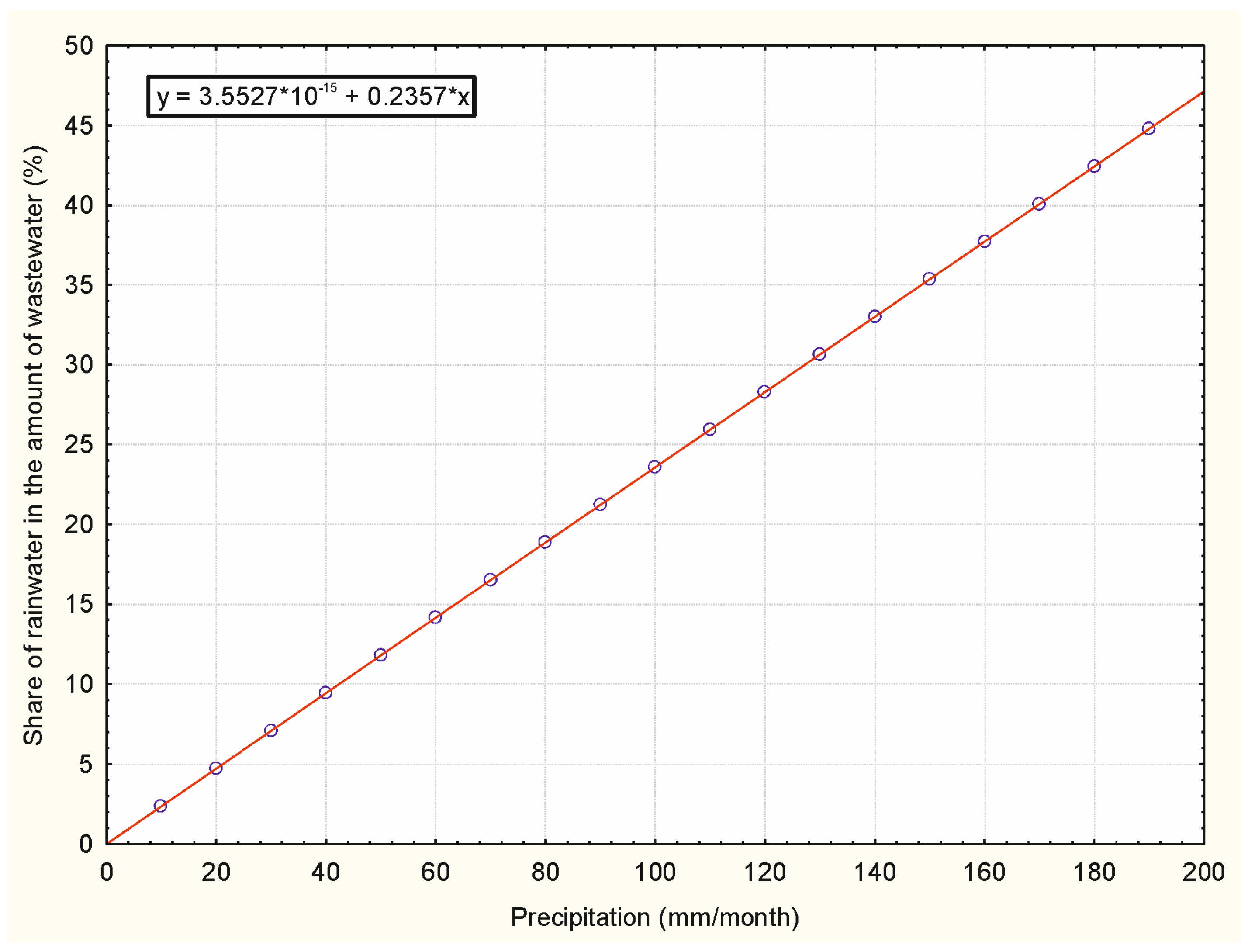
| Parameter | Standard Value in the Outflow [mg/L] |
|---|---|
| COD | 150 |
| BOD5 | 40 |
| Total suspension | 50 |
| Total nitrogen | 30 |
| Total phosphorous | 5 |
| Parameter | Sampling Site | Min [mg/L] | Max [mg/L] | Mean [mg/L] | Standard Deviation [mg/L] | Coefficient of Variation [%] |
|---|---|---|---|---|---|---|
| TSS | inlet | 27 | 375 | 128.1 | 93.2 | 73 |
| outlet | 4 | 96 | 30.8 | 23.3 | 76 | |
| BOD5 | inlet | 17 | 344 | 164.8 | 81.9 | 50 |
| outlet | 6 | 64 | 25.1 | 16.1 | 64 | |
| COD | inlet | 50 | 670 | 330.6 | 174.5 | 53 |
| outlet | 36 | 91 | 61.0 | 16.3 | 27 | |
| TN | inlet | 18 | 135 | 68.9 | 26.9 | 39 |
| outlet | 11 | 77 | 45.6 | 17.7 | 39 | |
| TP | inlet | 4 | 78 | 24.6 | 19.8 | 80 |
| outlet | 3 | 17 | 9.1 | 3.8 | 42 |
| Parameter | Sampling Site | Min [mg/L] | Max [mg/L] | Mean [mg/L] | Standard Deviation [mg/L] | Coefficient of Variation [%] |
|---|---|---|---|---|---|---|
| TSS | Influent | 27 | 347 | 112.7 | 76.8 | 68 |
| Effluent | 2.2 | 90.0 | 38.6 | 24.6 | 64 | |
| BOD5 | Influent | 63 | 395 | 168.6 | 83.7 | 50 |
| Effluent | 1 | 162 | 29.7 | 36 | 122 | |
| COD | Influent | 114 | 520 | 315.9 | 138.9 | 44 |
| Effluent | 19 | 230 | 62 | 49 | 79 | |
| TN | Influent | 24 | 103 | 69.4 | 22.5 | 32 |
| Effluent | 19 | 96 | 51.1 | 19.3 | 38 | |
| TP | Influent | 5.5 | 37.4 | 18.3 | 8.7 | 47 |
| Effluent | 2 | 26 | 9 | 5.2 | 58 |
| Parameter | Shapiro–Wilk Statistica “W” | Statistical Significance “p” | |
|---|---|---|---|
| Temperature | Growing period | 0.906 | 0.054 |
| Precipitation | 0.951 | 0.385 | |
| TSS | 0.890 | 0.269 | |
| BOD5 | 0.932 | 0.170 | |
| COD | 0.963 | 0.613 | |
| TN | 0.973 | 0.816 | |
| TP | 0.960 | 0.540 | |
| Temperature | Outgrowing period | 0.935 | 0.195 |
| Precipitation | 0.857 | 0.007 | |
| TSS | 0.961 | 0.558 | |
| BOD5 | 0.655 | 0.001 | |
| COD | 0.718 | 0.001 | |
| TN | 0.943 | 0.268 | |
| TP | 0.819 | 0.002 |
| Factor | Growing Season | Non-Growing Season | ||||||||
|---|---|---|---|---|---|---|---|---|---|---|
| TSS | BOD5 | COD | TN | TP | TSS | BOD5 | COD | TN | TP | |
| Precipitation | −0.31 * | −0.32 * | −0.02 | 0.04 | −0.14 | −0.59 * | −0.19 | −0.17 | −0.35 * | −0.38 * |
| Temperature | −0.43 * | −0.41 * | −0.09 | −0.03 | −0.08 | −0.37 * | −0.39 * | −0.34 * | −0.26 | −0.44 * |
Disclaimer/Publisher’s Note: The statements, opinions and data contained in all publications are solely those of the individual author(s) and contributor(s) and not of MDPI and/or the editor(s). MDPI and/or the editor(s) disclaim responsibility for any injury to people or property resulting from any ideas, methods, instructions or products referred to in the content. |
© 2023 by the authors. Licensee MDPI, Basel, Switzerland. This article is an open access article distributed under the terms and conditions of the Creative Commons Attribution (CC BY) license (https://creativecommons.org/licenses/by/4.0/).
Share and Cite
Operacz, A.; Jóźwiakowski, K.; Rodziewicz, J.; Janczukowicz, W.; Bugajski, P. Impact of Climate Conditions on Pollutant Concentrations in the Effluent from a One-Stage Constructed Wetland: A Case Study. Sustainability 2023, 15, 13173. https://doi.org/10.3390/su151713173
Operacz A, Jóźwiakowski K, Rodziewicz J, Janczukowicz W, Bugajski P. Impact of Climate Conditions on Pollutant Concentrations in the Effluent from a One-Stage Constructed Wetland: A Case Study. Sustainability. 2023; 15(17):13173. https://doi.org/10.3390/su151713173
Chicago/Turabian StyleOperacz, Agnieszka, Krzysztof Jóźwiakowski, Joanna Rodziewicz, Wojciech Janczukowicz, and Piotr Bugajski. 2023. "Impact of Climate Conditions on Pollutant Concentrations in the Effluent from a One-Stage Constructed Wetland: A Case Study" Sustainability 15, no. 17: 13173. https://doi.org/10.3390/su151713173
APA StyleOperacz, A., Jóźwiakowski, K., Rodziewicz, J., Janczukowicz, W., & Bugajski, P. (2023). Impact of Climate Conditions on Pollutant Concentrations in the Effluent from a One-Stage Constructed Wetland: A Case Study. Sustainability, 15(17), 13173. https://doi.org/10.3390/su151713173










